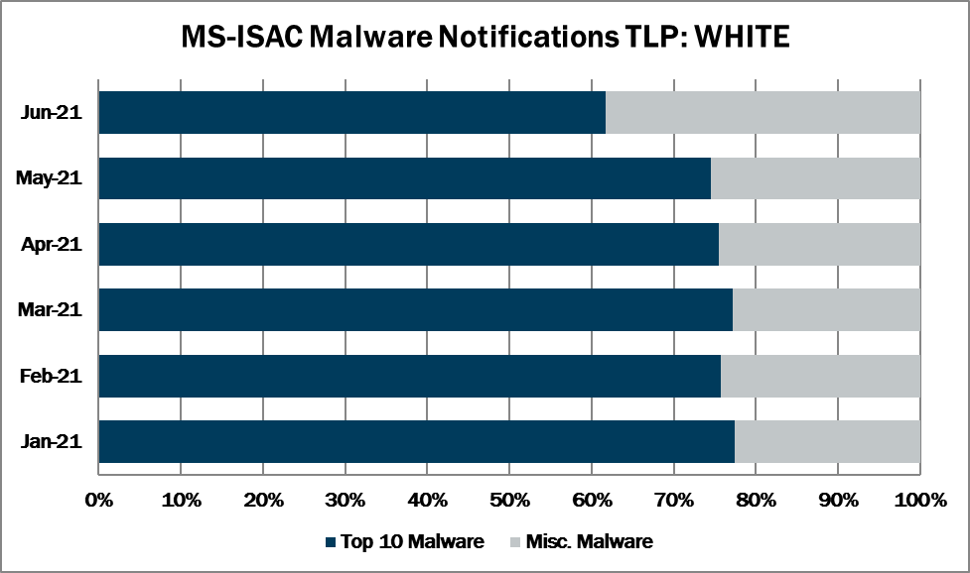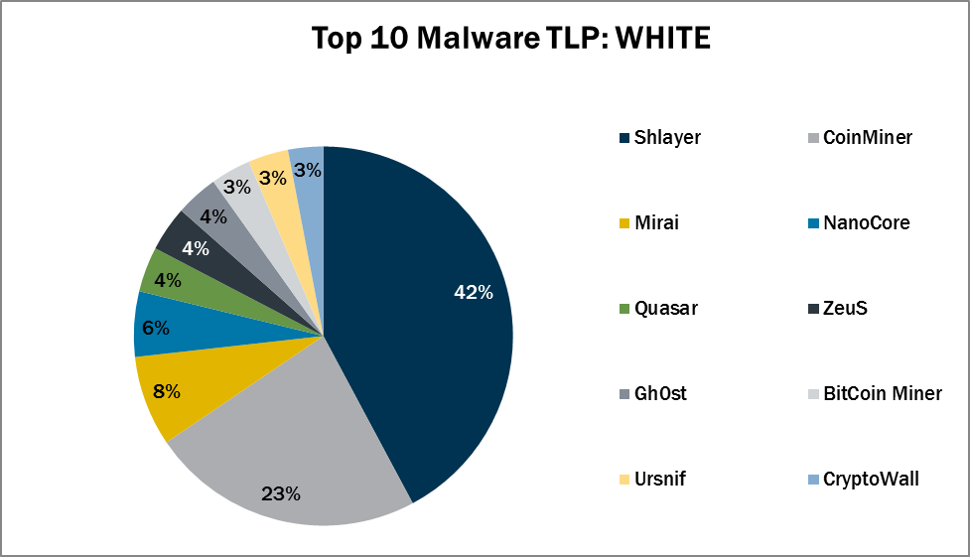Top 10 Malware June 2021


In June 2021, malvertisement accounted for the greatest number of alerts. Malvertisement continues as the top initial infection vector due to Shlayer activity. Activity levels for dropped increased, while activity for malspam, malvertisement, and multiple decreased.
Shlayer activity dropped 57% from the previous month likely due to the recent patch from Apple affecting its campaign. The patch fixes a zero-day vulnerability exploited by Shlayer to bypass Apple’s Gatekeeper, File Quarantine, and Notarization security checks. The patch will likely affect Shlayer’s ability to download second-stage malicious payloads, as well as its ability to download its own payload. However, it is unlikely to stop its initial infection vector as a whole. It is likely that malvertisement will remain the primary infection vector as the Shlayer campaign pans out.

Dropped – Malware delivered by other malware already on the system, an exploit kit, infected third-party software, or manually by a cyber threat actor. Mirai and Gh0st are the only malware dropped.
Multiple – Malware that currently favors at least two vectors. Currently, BitCoin Miner, CoinMiner, CryptoWall, and ZeuS are the malware utilizing multiple vectors. ZeuS is dropped by other malware, but it is also delivered via malvertisement.
Malspam – Unsolicited emails, which either direct users to malicious web sites or trick users into downloading or opening malware. The Top 10 Malware using this technique are NanoCore, Quasar, and Ursnif.
Malvertisement – Malware introduced through malicious advertisements. Currently, Shlayer is the only Top 10 Malware using this technique.
Top 10 Malware and IOCs
Below are the Top 10 Malware ranked in order of prevalence. The respective indicators of compromise (IOCs) are provided to aid in detecting and preventing infections from these Top 10 Malware variants. Note: The associated URIs are aligned with malware’s respective domain(s) or IP(s) and increase the likelihood of maliciousness when found together. The URIs alone are not inherently malicious.
1. Shlayer
Shlayer is a downloader and dropper for MacOS malware. It is primarily distributed through malicious websites, hijacked domains, and malvertizing posing as a fake Adobe Flash updater.
All Shlayer domains follow the same pattern
Domains
- api[.]interfacecache[.]com
- api[.]scalableunit[.]com
- api[.]typicalconfig[.]com
- api[.]standartanalog[.]com
- api[.]fieldenumerator[.]com
- api[.]practicalsprint[.]com
- api[.]searchwebsvc[.]com
- api[.]connectedtask[.]com
- api[.]navigationbuffer[.]com
- api[.]windowtask[.]com
2. CoinMiner
CoinMiner is a cryptocurrency miner that uses Windows Management Instrumentation (WMI) and EternalBlue to spread across a network. CoinMiner uses the WMI Standard Event Consumer scripting to execute scripts for persistence. CoinMiner spreads through malspam or is dropped by other malware.
3. Mirai
Mirai is a malware botnet known to compromise internet of things (IoT) devices in order to conduct large-scale DDoS attacks. Mirai is dropped after an exploit has allowed the attacker to gain access to a machine.
4. NanoCore
NanoCore is a RAT spread via malspam as a malicious Excel XLS spreadsheet. As a RAT, NanoCore can accept commands to download and execute files, visit websites, and add registry keys for persistence.
5. Quasar
Quasar is an open-source remote administration tool on the Windows Platform. It is used as a RAT to create backdoors.
6. ZeuS
ZeuS is a modular banking trojan which uses keystroke logging to compromise victim credentials when the user visits a banking website. Since the release of the ZeuS source code in 2011, many other malware variants have adopted parts of its codebase, which means that events classified as ZeuS may actually be other malware using parts of the ZeuS code.
7. Gh0st
Gh0st is a RAT used to control infected endpoints. Gh0st is dropped by other malware to create a backdoor into a device that allows an attacker to fully control the infected device.
8. BitCoin Miner
BitCoin Miner is a cryptocurrency miner that uses your computer’s resources to set up bitcoin blocks and forward them to a remote server.
9. Ursnif
Ursnif, and its variant Dreambot, are banking trojans known for weaponizing documents. Ursnif recently upgraded its web injection attacks to include TLS callbacks in order to obfuscate against anti-malware software. Ursnif collects victim information from login pages and web forms.
10. CryptoWall
CryptoWall is a ransomware commonly distributed through malspam with malicious ZIP attachments, Java Vulnerabilities, and malicious advertisements. Upon successful infection, CryptoWall will scan the system for drive letters, network shares, and removable drives. CryptoWall runs on both 32-bit and 64-bit systems.
![]()